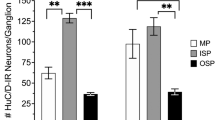Abstract
Background
Cystic fibrosis transmembrane conductance regulator (CFTR) was recently found in the enteric nervous system, where its role is unclear. We aimed to identify which enteric neuronal structures express CFTR, whether CFTR modulates enteric neurotransmission and if altered CFTR expression is associated with slow transit constipation (STC).
Methods
Immunofluorescence double labeling was performed to localize CFTR with various neuronal and glial cell markers in the human colon. The immunoreactivity (IR) of CFTR and choline acetyltransferase (ChAT) on myenteric plexus of control and STC colon was quantitatively analyzed. In control colonic muscle strips, electrical field stimulation (EFS) evoked contractile responses and the release of acetylcholine (ACh) was measured in the presence of the CFTR channel inhibitor, CFTR(inh)-172.
Results
CFTR-IR was densely localized to myenteric ganglia, where it was co-localized with neuronal markers HuC/D and β-tubulin, and glial marker S-100 but little with glial fibrillary acidic protein. Vesicular ACh transport was almost exclusively co-localized with CFTR, but neurons expressing nitric oxide synthase were CFTR negative. Significant reductions of CFTR-IR (P < 0.01) and ChAT-IR (P < 0.05) were observed on myenteric ganglia of STC compared to control. Pre-treatment of colonic muscle strips with CFTR(inh)-172 (10 µM) significantly inhibited EFS-evoked contractile responses (P < 0.01) and ACh release (P < 0.05).
Conclusions
Co-localization of CFTR-IR with cholinergic markers, inhibition of EFS-induced colonic muscle contractility and ACh release by CFTR(inh)-172 suggest that CFTR modulates enteric cholinergic neurotransmission. The downregulation of CFTR and ChAT in myenteric ganglia of STC correlated with the impaired contractile responses to EFS.







Similar content being viewed by others
References
Gustafsson JK, Ermund A, Ambort D, et al. Bicarbonate and functional CFTR channel are required for proper mucin secretion and link cystic fibrosis with its mucus phenotype. J Exp Med. 2012;209:1263–72.
Char JE, Wolfe MH, Cho HJ, et al. A little CFTR goes a long way: CFTR-dependent sweat secretion from G551D and R117H–5T cystic fibrosis subjects taking ivacaftor. PLoS ONE. 2014;9:e88564.
Oca F, Dreux S, Gerard B, et al. Amniotic Fluid Digestive Enzyme Analysis Is Useful for Identifying CFTR Gene Mutations of Unclear Significance. Clin Chem. 2009;55:2214–7.
Sorio C, Buffelli M, Angiari C, et al. Defective CFTR expression and function are detectable in blood monocytes: development of a new blood test for cystic fibrosis. PLoS ONE. 2011;6:e22212.
Johansson J, Vezzalini M, Verze G, et al. Detection of CFTR protein in human leukocytes by flow cytometry. Cytometry A. 2014;85:611–20.
Verloo P, Kocken CH, Van der Wel A, et al. Plasmodium falciparum-activated chloride channels are defective in erythrocytes from cystic fibrosis patients. J Biol Chem. 2004;279:10316–22.
Su M, Guo Y, Zhao Y, et al. Expression of cystic fibrosis transmembrane conductance regulator in paracervical ganglia this paper is one of a selection of papers published in this special issue entitled “Second International Symposium on Recent Advances in Basic, Clinical, and Social Medicine” and has undergone the journal's usual peer review process. Biochem Cell Biol. 2010;88:747–55.
Riordan JR, Rommens JM, Kerem B, et al. Identification of the cystic fibrosis gene: cloning and characterization of complementary DNA. Science. 1989;245:1066–73.
Dalli J, Rosignoli G, Hayhoe RP, et al. CFTR inhibition provokes an inflammatory response associated with an imbalance of the annexin A1 pathway. Am J Pathol. 2010;177:176–86.
Malats N, Casals T, Porta M, et al. Cystic fibrosis transmembrane regulator (CFTR) ΔF508 mutation and 5T allele in patients with chronic pancreatitis and exocrine pancreatic cancer. Gut. 2001;48:70–4.
McLatchie LM, Young JS, Fry CH. Regulation of ACH release from guinea pig bladder urothelial cells: potential role in bladder filling sensations. Br J Pharmacol. 2014;171:3394–403.
Ochodnicky P, Michel MB, Butter JJ, et al. Bradykinin modulates spontaneous nerve growth factor production and stretch-induced ATP release in human urothelium. Pharmacol Res. 2013;70:147–54.
Lubowski DZ, Chen FC, Kennedy ML, et al. Results of colectomy for severe slow transit constipation. Dis Colon Rectum. 1996;39:23–9.
Wong SW, Lubowski DZ. Slow-transit constipation: evaluation and treatment. ANZ J Surg. 2007;77:320–8.
Preston DM, Lennardjones JE. Severe chronic constipation of young-women - idiopathic slow transit constipation. Gut. 1986;27:41–8.
Bassotti G, Villanacci V, Maurer CA, et al. The role of glial cells and apoptosis of enteric neurones in the neuropathology of intractable slow transit constipation. Gut. 2006;55:41–6.
Tomita R, Tanjoh K, Fujisaki S, et al. Regulation of the enteric nervous system in the colon of patients with slow transit constipation. Hepatogastroenterology. 2002;49:1540–4.
Liu L, Shang F, Morgan MJ, et al. Cyclooxygenase-dependent alterations in substance P-mediated contractility and tachykinin NK1 receptor expression in the colonic circular muscle of patients with slow transit constipation. J Pharmacol Exp Ther. 2009;329:282–9.
Jung HK, Kim DY, Moon IH. Effects of gender and menstrual cycle on colonic transit time in healthy subjects. Korean J Intern Med. 2003;18:181.
Björnsson ES, Chey WD, Hooper F, et al. Impaired gastrocolonic response and peristaltic reflex in slow-transit constipation: role of 5-HT3 pathways. Am J Physiol Gastrointest Liver Physiol. 2002;283:G400–G407407.
Frattini JC, Nogueras JJ. Slow transit constipation: a review of a colonic functional disorder. Clin Colon Rectal Surg. 2008;21:146–52.
Wong SW, Lubowski DZJ. Slow‐transit constipation: evaluation and treatment. ANZ J Surg. 2007;77:320–8.
Strong TV, Boehm K, Collins FS. Localization of cystic fibrosis transmembrane conductance regulator mRNA in the human gastrointestinal tract by in situ hybridization. J Clin Invest. 1994;93:347–54.
Beyder A, Farrugia G. Ion channelopathies in functional GI disorders. Am J Physiol Gastrointest Liver Physiol. 2016;311:G581–G586586.
Cil O, Phuan PW, Lee S, et al. CFTR activator increases intestinal fluid secretion and normalizes stool output in a mouse model of constipation. Cell Mol Gastroenterol Hepatol. 2016;2:317–27.
Sharma S, Sharma T, Dhingra R, et al. Linaclotide-a novel secretagogue in the treatment of irritable bowel syndrome with constipation and chronic idiopathic constipation. Mini Rev Med Chem. 2013;13:1685–90.
Xue R, Gu H, Qiu Y, et al. Expression of cystic fibrosis transmembrane conductance regulator in ganglia of human gastrointestinal tract. Sci Rep. 2016;6:30926.
Varghese F, Bukhari AB, Malhotra R, et al. IHC Profiler: an open source plugin for the quantitative evaluation and automated scoring of immunohistochemistry images of human tissue samples. PLoS ONE. 2014;9:e96801.
Dhooghe B, Noel S, Bouzin C, et al. Correction of chloride transport and mislocalization of CFTR protein by vardenafil in the gastrointestinal tract of cystic fibrosis mice. PLoS ONE. 2013;8:e77314.
Doucet L, Mendes F, Montier T, et al. Applicability of different antibodies for the immunohistochemical localization of CFTR in respiratory and intestinal tissues of human and murine origin. J Histochem Cytochem. 2003;51:1191–9.
Valdivieso AG, Marin MC, Clauzure M, et al. Measurement of cystic fibrosis transmembrane conductance regulator activity using fluorescence spectrophotometry. Anal Biochem. 2011;418:231–7.
Walsh DE, Harvey BJ, Urbach V. CFTR regulation of intracellular calcium in normal and cystic fibrosis human airway epithelia. J Membr Biol. 2000;177:209–19.
Billet A, Luo Y, Balghi H, et al. Role of tyrosine phosphorylation in the muscarinic activation of the cystic fibrosis transmembrane conductance regulator (CFTR). J Biol Chem. 2013;288:21815–233.
Billet A, Hanrahan JW. The secret life of CFTR as a calcium-activated chloride channel. J Physiol. 2013;591:5273–8.
Thiagarajah JR, Song Y, Haggie PM, et al. A small molecule CFTR inhibitor produces cystic fibrosis-like submucosal gland fluid secretions in normal airways. FASEB J. 2004;18:875–7.
Leveque M, Penna A, Le Trionnaire S, et al. Phagocytosis depends on TRPV2-mediated calcium influx and requires TRPV2 in lipids rafts: alteration in macrophages from patients with cystic fibrosis. Sci Rep-Uk. 2018;8:4310.
Zhao YM, Migita K, Sun J, et al. MRP transporters as membrane machinery in the bradykinin-inducible export of ATP. N-S Arch Pharmacol. 2010;381:315–20.
Braunstein GM, Roman RM, Clancy JP, et al. Cystic fibrosis transmembrane conductance regulator facilitates ATP release by stimulating a separate ATP release channel for autocrine control of cell volume regulation. J Biol Chem. 2001;276:6621–30.
Wedel T, Roblick UJ, Ott V, et al. Oligoneuronal hypoganglionosis in patients with idiopathic slow-transit constipation. Dis Colon Rectum. 2002;45:54–62.
Park HJ, Kamm MA, Abbasi AM, et al. Immunohistochemical study of the colonic muscle and innervation in idiopathic chronic constipation. Dis Colon Rectum. 1995;38:509–13.
Broadhead MJ, Bayguinov PO, Okamoto T, et al. Ca2+ transients in myenteric glial cells during the colonic migrating motor complex in the isolated murine large intestine. J Physiol. 2012;590:335–50.
Boesmans W, Lasrado R, Vanden Berghe P, et al. Heterogeneity and phenotypic plasticity of glial cells in the mammalian enteric nervous system. GLIA. 2015;63:229–41.
MacEachern SJ, Patel BA, McKay DM, et al. Nitric oxide regulation of colonic epithelial ion transport: a novel role for enteric glia in the myenteric plexus. J Physiol. 2011;589:3333–48.
De Giorgio R, Giancola F, Boschetti E, et al. Enteric glia and neuroprotection: basic and clinical aspects. Am J Physiol Gastrointest Liver Physiol. 2012;303:G887–G89393.
Gulbransen BD, Sharkey KA. Novel functional roles for enteric glia in the gastrointestinal tract. Nat Rev Gastroenterol Hepatol. 2012;9:625–32.
Neunlist M, Van Landeghem L, Mahé MM, et al. The digestive neuronal–glial–epithelial unit: a new actor in gut health and disease. Nat Rev Gastroenterol Hepatol. 2013;10:90–100.
Bassotti G, Chiarioni G, Imbimbo BP, et al. Impaired colonic motor response to cholinergic stimulation in patients with severe chronic idiopathic (slow transit type) constipation. Dig Dis Sci. 1993;38:1040–5.
Wedel T, Spiegler J, Soellner S, et al. Enteric nerves and interstitial cells of Cajal are altered in patients with slow-transit constipation and megacolon. Gastroenterology. 2002;123:1459–67.
De Lisle RC. Altered transit and bacterial overgrowth in the cystic fibrosis mouse small intestine. Am J Physiol Gastrointest Liver Physiol. 2007;293:G104–G111111.
Lynch SV, Goldfarb KC, Wild YK, et al. Cystic fibrosis transmembrane conductance regulator knockout mice exhibit aberrant gastrointestinal microbiota. Gut Microbes. 2013;4:41–7.
De Lisle RC, Meldi L, Flynn M, et al. Altered eicosanoid metabolism in the cystic fibrosis mouse small intestine. J Pediatr Gastroenterol Nutr. 2008;47:406–16.
De Lisle RC, Sewell R, Meldi L. Enteric circular muscle dysfunction in the cystic fibrosis mouse small intestine. Neurogastroenterol Motil. 2010;22:341–e87.
De Lisle RC, Borowitz D. The cystic fibrosis intestine. Cold Spring Harb Perspect Med. 2013;3:a009753.
Cil O, Phuan PW, Son JH, et al. Phenylquinoxalinone CFTR activator as potential prosecretory therapy for constipation. Transl Res. 2017;182(14–26):e4.
Acknowledgments
This study was supported by a project Grant from the National Health and Medical Research Council of Australia (APP1048885), and by the UNSW and Shanghai Jiao Tong University Collaborative Seed Grant. We would like to offer our special thanks to Stelina Drimousis and Erica Diezmos in specimen collection and preparation.
Author information
Authors and Affiliations
Corresponding author
Ethics declarations
Conflict of interest
There are no conflicts of interest.
Additional information
Publisher's Note
Springer Nature remains neutral with regard to jurisdictional claims in published maps and institutional affiliations.
Electronic supplementary material
Below is the link to the electronic supplementary material.
Rights and permissions
About this article
Cite this article
Yeh, K.M., Johansson, O., Le, H. et al. Cystic fibrosis transmembrane conductance regulator modulates enteric cholinergic activities and is abnormally expressed in the enteric ganglia of patients with slow transit constipation. J Gastroenterol 54, 994–1006 (2019). https://doi.org/10.1007/s00535-019-01610-9
Received:
Accepted:
Published:
Issue Date:
DOI: https://doi.org/10.1007/s00535-019-01610-9




